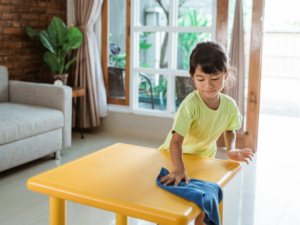The importance of routines is to support your child’s healthy growth and progress by establishing a consistent schedule and regular routines. Research shows that routines are key in creating a foundation for cognitive development, acquiring language and social skills, and behavior regulation.
Why are Routines Important in Early Childhood?
Routines provide structure and stability in our daily lives. Without them, we would be challenged to navigate the daily demands of work and personal responsibilities, leading to feelings of stress and disorganization. Kids are not much different. Routines provide a host of benefits for them:
Safety & Comfort
Routines can provide babies and young children with a sense of safety and comfort. When a child feels safe and comfortable, they can spend more time learning and growing.
School Readiness
Consistent routines have been shown to be important for preparing young children for school. Research indicates that children who have experienced routines before starting school had a smoother transition, allowing them to easily grasp academic concepts easily
Parenting Skills
Not only do routines have many benefits for healthy child development but they also have been found to increase parent satisfaction and confidence with parenting skills
In order for a routine to make the most impact, the routine should be predictable. This means that a routine is more than just a schedule or a plan for the day. Instead, the routine should be a specific way everyday tasks are completed that is easily recognizable by your child after a few times of doing it. Routines can exist around activities that are done every day, such as waking up, going to sleep, eating, and even playing. Let’s consider routines by age range:
Importance of Routines in Infants and Babies
Routines can be established around bedtime and feeding for infants and babies (0-1). The times that your infant or baby needs food or sleep will depend on them. One way to help your baby feel safe and comfortable is to help them learn the difference between night and day and recognize when it is time to go to bed.
Teach the difference between night and day
- Change their clothes before bed (e.g., pajamas) and then again when they wake up (e.g., play clothes)
- Keep your house bright (open curtains for sunlight) during the day with (talking and/or music) and darker at night (quieter and calming)
- When feeding during the day, feed in a bright location and talk to your baby.
- When feeding at night, feed in a dark and calming location and keep talking to a minimum.
Establish a bedtime routine
- Keep it short (around 30 to 45 minutes), simple, and consistent.
- Give them a bath and/or change their diaper/clothes
- Feed in their room (whether you are breastfeeding or using a bottle) with the lights dimmed
- Sing them a lullaby or read a story and give lots of cuddles
- Put them in their crib and tell them “goodnight” or “night, night” (use the same words each time)
The Importance of Routines for Toddlers
For toddlers (2-3), routines can be established around bedtime, waking up, bath time, playtime, meals, and daycare drop off/pick up (if applicable). At this age, routines can help your toddler develop a sense of time (for example: when it gets dark outside, that signals the start of bedtime rituals). You can help your toddler learn their routines by the language that you use.
Use Simple Language
- Use simple language that reminds your child of the steps to the routine as you do them (for example: First, Next, Then). This will build your child’s self-talk (internal dialogue), which will help them become more independent at doing tasks on their own.
- Use similar words and phrases each time you complete the routine. For example: “It’s time to eat now. First, we wash our hands. Next, we grab our plates. Then, we sit in our chairs at the table.”
- Don’t say the next part of the routine until the first part has been completed.
- Pair the verbal reminders of the routine with visuals.
- For lunchtime (or any mealtime), have a picture of washing hands, a picture of a plate, and a picture of a chair at a table to help remind your child about the things that must happen as part of getting ready to eat a meal.
- As you say each part of the routine, point to the picture representing that step. Referring to pictures representing parts of the routine will help your child learn the routine.
- To build independence, you can ask your child, “What do we do next?” and ask them to point to the picture for the next part of the routine.
Mealtime Routines
- Be Consistent, Be Safe, and Be Focused4.
- Toddlers are more likely to eat if meals and snacks happen at the same time each day.
- Always try to eat at the table or another place that allows for sitting down. Eat at this place as often as possible for snacks and meals. Strap your child into their highchair or booster seat to ensure they are safe.
- Help your child clean their hands (at a sink or using a wipe) before giving them food.
- Remove as many distractions during mealtime as possible. Turn off any screens so that your toddler can focus on eating.
- Mealtimes can be short, 10 to 15 minutes, as long as your child can stay focused on eating.
Importance of Routines for Preschoolers
For children ages 4-5, the same routines that you created when they were younger can be adapted to let your child begin to do things by themselves. Growing their independence will help build their self-confidence. One way to help your child become more independent is by giving them more responsibility in their routine.
Tips for growing independence in routines:
- Make a checklist of the steps included in the routine.
- Allow your child to do each step on their own, checking in with you after each one. This method may take more time to complete. Allow extra time so you and your child do not feel rushed.
- To prepare for the extra time, you might consider doing parts of the routine ahead of time. For example, if you are letting your child get dressed on their own, help them pick out their own clothing the night before and lay everything out. This might save some time in the morning and can reduce stress many choices while also allowing your child to dress themselves.
A visual schedule, also known as a picture schedule, is a great tool for letting your child start their routine on their own.




